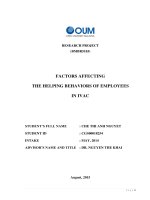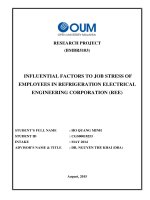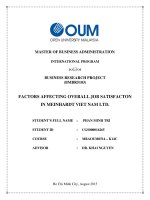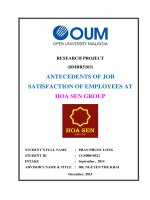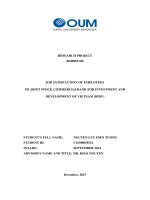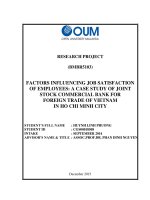Factors affecting to job satisfaction of employees in VPBank
Bạn đang xem bản rút gọn của tài liệu. Xem và tải ngay bản đầy đủ của tài liệu tại đây (691.09 KB, 84 trang )
RESEARCH PROJECT
(BMBR5103)
FACTORS AFFECTING TO JOB SATISFACTION OF EMPLOYEES IN
VPBANK
STUDENT’S FULL NAME
: TRAN QUOC HUNG
STUDENT ID
: CGS00018556
INTAKE
: SEPTEMBER, 2014
ADVISOR’S NAME & TITLE : ASSOC PROF DR. PHAN DINH NGUYEN
December, 2015
1
Advisor’s assessment
............................................................................................................................................
............................................................................................................................................
............................................................................................................................................
............................................................................................................................................
............................................................................................................................................
............................................................................................................................................
............................................................................................................................................
............................................................................................................................................
............................................................................................................................................
............................................................................................................................................
............................................................................................................................................
............................................................................................................................................
............................................................................................................................................
............................................................................................................................................
............................................................................................................................................
Advisor’s signature
2
Thank you
I would like to thank the teachers from HUTECH and OBM has taught me to convey to
you the knowledge foundation newspaper for making this thesis.
I would like to thank Dr. Nguyen Phan was enthusiastic guidance and direction so I
could finish this essays.
I also would like to thank all friends, former colleagues and those who helped me
answer a questionnaire survey as a source of data for analysis and the research results
of this essays.
3
Thesis Summary
The theme uses quantitative research methods to determine job satisfaction of VPBank
staff block in Ho Chi Minh City and the factors affecting this satisfaction. The data
used in this study were collected from questionnaires sent to the VPBank staff block in
HCMC. From the theory of job satisfaction and the practical research of the researchers
in this matter the scale factors of job satisfaction has been built with five level Likert
scale.
Linear regression models were built originally with the dependent variable is the job
satisfaction of employees and seven independent variables include: satisfaction for
income, education promotion, superiors, Colleagues, job characteristics, working
conditions and company benefits.
Results of regression analysis showed that six factors that affect statistical significant
job satisfaction of office workers in the city. Of these three factors influence the
satisfaction of income, job characteristics and superior and three major factors that
influence the satisfaction for the promotion of training, and basic welfare benefits plus
4
Category
CHAPTER 1: INTRODUCTION
1.1 Question .................................................................................................................. 9
1.2 Research objectives................................................................................................ 10
1.3 Object and scope of research ................................................................................ 10
1.4 Research Methods.................................................................................................. 11
1.5 Meaning topics ....................................................................................................... 11
1.6 The structure of the thesis..................................................................................... 12
CHAPTER 2: THEORETICAL FOUNDATIONS ................................................. 14
2.1. Introduction .......................................................................................................... 14
2.2. The theory of job satisfaction .............................................................................. 14
2.2.1. Concept............................................................................................................... 14
2.2.2. The theory of job satisfaction ........................................................................... 15
2.2.2.1. The theory of Maslow's needs hierarchy (1943) .......................................... 15
2.2.2.2. Theoretical achievements of McClelland (1988) ......................................... 16
2.2.2.3. Vroom's expectancy theory (1964) ............................................................... 17
2.2.2.4. Equity theory of Adam (1963) ....................................................................... 18
2.2.2.5. The causes of job satisfaction ........................................................................ 19
2.3. The research related to job satisfaction ............................................................. 20
2.4. Model research and evaluation index factors of job satisfaction .................... 23
5
2.4.1. Definition of factors: ......................................................................................... 24
2.4.2. Research model.................................................................................................. 27
2.4.3. Index evaluation factors of job satisfaction .................................................... 27
2.5. Summary ............................................................................................................... 29
CHAPTER 3: RESEARCH METHOD .................................................................... 30
3.1. Designed research................................................................................................. 31
3.1.1. The scale ............................................................................................................. 31
3.1.2. Sampling............................................................................................................. 32
3.1.2.1. Overall ............................................................................................................. 32
3.1.2.2. Sampling method ............................................................................................ 33
3.1.2.3. Sample Size ..................................................................................................... 34
3.1.3. Tools to collect information – questionnaire: ................................................. 35
3.1.4. The process of collecting information ............................................................. 36
3.2. Technical analysis of statistical data .................................................................. 37
3.2.1. Check the reliability of the scale ...................................................................... 37
3.2.2. Correlation coefficients and linear regression analysis ................................. 38
CHAPTER 4: RESULTS OF RESEARCH .............................................................. 39
4.1. Eliminate the answer sheet mismatch, cleaning and coding data ................... 39
4.1.1. Eliminate the answer sheet mismatch ............................................................. 39
6
4.1.2. Cleaning data ..................................................................................................... 39
4.1.3. Data encryptation .............................................................................................. 40
4.2. Description Sample .............................................................................................. 40
4.2.1. Structural characteristics of the sample ......................................................... 40
4.2.2. Job satisfaction of sample ................................................................................. 44
4.3. Analysis of the reliability and relevance of the scale ........................................ 45
4.3.1. Cronbach's alpha coefficients .......................................................................... 45
4.3.1.1. The scale of each factor of job satisfaction .................................................. 46
4.3.1.2. Scale general job satisfaction ........................................................................ 48
4.4. Accreditation job satisfaction of the overall figure ........................................... 49
4.4.1. The overall job satisfaction of office workers in the HCMC ........................ 49
4.4.2. Job satisfaction between men and women ...................................................... 49
4.4.3. Job satisfaction with age ................................................................................... 50
4.4.4. Job satisfaction over time work ....................................................................... 52
4.4.5. Job satisfaction by level, title and type of enterprise ..................................... 52
4.5 Linear Regression Analysis .................................................................................. 52
4.5.1.1 A correlation matrix between variables ........................................................ 54
4.5.1.2 Construction of linear regression equation. ................................................. 55
4.5.1.3 Review the relevance of the model and test hypotheses .............................. 56
7
4.5.1.4 Explain the importance of the variables in the model ................................. 57
4.5.1.5 Detect a violation of assumptions required in linear regression................. 58
4.6. Summary of Result of research: ......................................................................... 59
CHAPTER 5: CONCLUSIONS AND RECOMMENDATIONS ........................... 61
5.1. Conclusion on job satisfaction ............................................................................ 61
5.2. Recommendations for the use of labor ............................................................... 63
5.2.1. Income ................................................................................................................ 63
5.2.2. Job Characteristics............................................................................................ 65
5.2.3. Superior .............................................................................................................. 65
5.2.4. Advance training ............................................................................................... 67
5.2.5. Welfare/Benefit .................................................................................................. 68
5.2.6. Other Note .......................................................................................................... 69
5.3. Limitations of this study and recommendations for future research.............. 70
References .................................................................................................................... 72
8
CHAPTER 1: INTRODUCTION
1.1. Question
Along with the development of Vietnam's economy in recent years, the demand for
human resources is also increasing. Enterprises are increasingly focused than the
issue of building human resources, especially recruiting the right person for their
company.
However, chose the right people you need is not enough, they must also know how
to keep their staff especially the core staff, hold a key role in the company. With
the shortage of human resources "capable" today, good staff retention becomes a
problem is the best business owners care.
The stability of the staff will help businesses save time and costs (recruitment,
training, etc.), reduction of errors (caused by new employees while not familiar
with the new work), create trust and solidarity within the enterprise. Since then
staff will see now is the ideal place for them to promote their capabilities as well as
long-term commitment to the business. Finally, most importantly, this stability will
help businesses operate more efficiently, creating the trust of customers for quality
products and services businesses.
So how to build a stable staff for your company? Many domestic and foreign
studies that need to create job satisfaction for employees. Once you have the job
satisfaction, employees will be motivated to work harder, which in turn leads to
efficiency and higher work efficiency. This is also something that business owners
wish to achieve from their staff.
9
This study was conducted to find out the purpose, reviews the current state of the
job satisfaction of office workers in the VPBank, and find out the factors affecting
this satisfaction. With data obtained from the survey and through processing,
statistical data analysis, this study provides hope for the enterprise managers
greater insight into the factors that may bring job satisfaction for employees. Thus
helping them with orientation and policies pertinent to employers, to retain
appropriate staff that managers wish them long-term commitment to the company
1.2. Research objectives
This study was conducted aimed at identifying the factors that influence job
satisfaction of office workers in VPBank with the following basic objectives:
- First, find out the overall job satisfaction and satisfaction on each factor, aspects
of job satisfaction of office workers in VPBank.
- Second, building and testing each element scales affect the job satisfaction scale
and general work satisfaction.
- Third, compare job satisfaction among office staff differ in gender, age, working
time, education, job placement and type of business they are working.
- Fourth, determine the strength of the factors affecting job satisfaction of office
workers in VPBank.
1.3. Object and scope of research
Study subjects as job satisfaction and factors affecting job satisfaction of
employees. By gathering information from those who were given a survey by
questionnaire to determine job satisfaction of employees in each job factors as
gratification for income, training promotion, superiors, colleagues, job
10
characteristics, working conditions and company benefits. The specific aspects of
each element is represented by the index (observed variables) were also considered
and verified. Finally, through analysis statistically the influence of each factor for
job satisfaction in general will be reviewed and determined.
The scope of the study is limited to the staff office, which does not include all
types of employees. Office workers who work in a corporate office or a company
or organization that (Oxford Advance Learner's Dictionary). Office workers here,
including junior employees and senior staff, but do not include the business
owners. Geographically, the survey topic only staff office blocks in the HCMC, no
surveying employees work in other provinces. Addressing only the study of job
satisfaction studies intended not change the company's employees work.
Implementation time the survey was in late 2015.
1.4. Research Methods
The theme uses quantitative research methods to explore, define job satisfaction of
employees. Five level Likert scale was used to measure the value of variables.
Since this study is the discovery, how sampling is designed non-probability
sampling with convenient sampling form.
Questionnaire answers itself will be used as a tool to collect information and data
necessary to serve the above quantitative analysis.
Thesis using statistical inference analysis of results obtained from the sample.
Cronbach's alpha was used to select and consolidate elements of the scale, EFA
factor analysis was used to determine factors hidden behind the observed variables.
Finally, linear regression analysis was used to determine the real factors that affect
job satisfaction as well as coefficients of these factors in linear regression equation.
11
1.5. Meaning topics
The topic has some meaning after:
First, the findings will give the reader get an overview of job satisfaction in the
factors, different aspects and the overall job satisfaction of staff office block in
HCMC. The study will also compare job satisfaction divided by gender, age,
education, job and location of the various types of enterprises.
Second, this study helps us identify the scale used to measure job satisfaction and
factors affecting job satisfaction of office workers, from which the managers of the
business, companies and organizations will build their organization appropriate
policies to improve the job satisfaction of office workers in their organizations.
Third, this study is the discovery, as a basis for further studies on job satisfaction of
employees in general and office workers in particular in Vietnam.
1.6. The structure of the thesis
Thesis is divided into five chapters.
Chapter 1 - Introduction to introduce the base shape topic, research objectives,
subject and scope of the research, research methodology and the meaning of the
subject.
Chapter 2 - Theoretical basis will introduce the theory, doctrine as the basis for the
study of job satisfaction, summarizes the empirical research on job satisfaction in
some areas in some states specific countries and regions. This chapter also
introduces research model built originally from theoretical basis.
12
Chapter 3 - Methodology will introduce about building scale, from sampling, data
collection tools, the process of gathering information and how to conduct technical
analysis of statistical data used in the subject.
Chapter 4 - Results of the study will analyze and interpret the data obtained from the
survey include the results of testing the reliability and the relevance scale and the
statistical inference result.
Chapter 5 - Conclusions and recommendations will give some conclusions from the
results obtained include conclusions on job satisfaction, a number of
recommendations to the employer and some restrictions and recommendations for
future research.
13
CHAPTER 2: THEORETICAL FOUNDATIONS
2.1. Introduction
This chapter will first introduce the concept of job satisfaction as well as theories
related to job satisfaction, motivating work includes such famous doctrine:
The theory of Maslow's needs hierarchy
McClelland Theory's achievements
Vroom's expectancy theory
Adam's equity theory
2.2. The theory of job satisfaction
2.2.1. Concept
There are many definitions of job satisfaction. Dictionary encyclopedia
wikipedia.com argue that job satisfaction is the satisfaction of an individual for his
or her job.
One of the first definition of job satisfaction and are cited as possible regardless of
the definition of Robert Hoppock. The author said that the measure of job
satisfaction by two
ways: (a) measuring job satisfaction in general and (b) measuring job satisfaction in
various aspects related to work. He also said that job satisfaction is generally not
merely total satisfaction of the different aspects, but the general job satisfaction can
be viewed as a separate variable.
According to Spector (1997) job satisfaction is job one feels like their job and their
job aspects like. Since it is the general assessment, so it is an attitudinal variables.
14
But Ellickson and Logsdon (2001) argue that job satisfaction is generally defined as
the degree favorite employee their job, that is the attitude based on the awareness of
employees (negative or pole) of work or their working environment. More simply,
the work environment as to meet the needs, values and personality of the employees,
job satisfaction is higher.
Schemerhon (1993) defines job satisfaction as the emotional reactions and feelings
towards different aspects of the work of the staff. The author emphasizes the causes
of job satisfaction include job placement, supervised by superiors, relationships with
colleagues, job content, the treatment, and the rewards include advance , physical
conditions of the workplace, as well as the structure of the organization
According Kreitner and Kinicki (2007), job satisfaction levels mainly reflect a
personal favorite of his work. That is the sentiment or the feelings of the employee
for his work.
So there are many different definitions of job satisfaction, but we can draw is that a
person is considered to have job satisfaction, he or she will be more comfortable,
pleasant to with his work. Concerning the causes leading to job satisfaction, each
researchers are looking, through its own interpretation of their work. The next
section refers to the theoretical with the practical research related to job satisfaction.
2.2.2. The theory of job satisfaction
Research on job satisfaction typically researchers associated with the theory of
encouragement and job satisfaction. The following is a summary of some notable
theory.
2.2.2.1. The theory of Maslow's needs hierarchy (1943)
15
Speaking of satisfaction in general people often mention the theory of Maslow's
needs hierarchy (1943). According to the human needs are divided into five levels
increased gradually: physiological, safety, social, self-esteem and self-expression.
After a certain demand has been satisfied, the demand in the next higher rank will
appear. From this theory, we can see that managers must know their employees are
in rank needs to thereby encourage their employees by meeting the needs of their
individual.
Selfexpress
ion
Self-respect
Society
Safe
Physiologic
Figure 2.1 The hierarchy of needs Maslow
"Source: Organizational Behavior"
This is the theory of human needs, and it is considered and applied in this study
because only when the needs of employees are met, they can have the satisfaction at
work. The demand in this theory are discussed in terms of different variables. For
example, the satisfaction of physiological needs and safety can be expressed in the
variables measuring the satisfaction of income and company benefits. Similarly, the
satisfaction of social needs and self-respect are shown in the variables expressed
satisfaction about the relationship with superiors and colleagues as well as current
variations certain autonomy in implementing the job.
2.2.2.2. Theoretical achievements of McClelland (1988)
16
McClelland's theory focuses on three types of human needs: the need for achievement,
need for power and the need for the alliance. They are defined as follows:
- The need for achievement is the effort to stand out, to achieve the desired results for
certain sets of standards, efforts to succeed.
- The need for power is the demand that other people behave the way they want.
- The need for the alliance's desire for friendly relations and close to other people.
Needs of McClelland achievements expressed in this research as job characteristics.
Work needs to be designed so that employees achieve "success" they wanted. But the
alliance needs to be expressed in relationships with superiors and colleagues. Finally,
the demand for power is expressed in the opportunity to be promoted.
2.2.2.3. Vroom's expectancy theory (1964)
Vroom said the behavior and motivation of people not necessarily be determined by the
reality that it is determined by the perception of people about their expectations for the
future. Maslow and Herzberg Unlike, Vroom does not focus on human needs that
focuses on results. This theory revolves around three basic concepts (Kreitner &
Kinicki, 2007) or three relationships:
- Expectancy is the belief that the effort will lead to good results. This concept is
expressed through the relationship between effort and performance.
- Instrumentality (engine characteristics): the belief that good results will lead to
rewards. This concept is reflected in the relationship between the performance and
outcome/rewards.
- Valence: the level of importance of the reward for the work done. This concept is
expressed through the relationship between rewards and personal goals.
17
Vroom said that only employees who are motivated when their perception of all three
concepts or three relationships on a positive. In other words if they believe their efforts
will produce better results, results which will lead to rewards and rewards that make
sense and fit with their individual targets.
Expectancy
Efforts
Instrumentality
Performance
Valence
Rewards
Personal goals
Figure 2.2: Victor Vroom's expectancy theory
Since this theory is based on the perception of workers should be able to happen in the
case is the same as a company and the same place as another, but a motivation to work
and the other does not due to receive their understanding of the concepts above are
different.
Application of this theory to the research topic of this thesis, we see that the workers
want the right direction towards a certain goal (of course objectives associated with the
organization's objectives), we have to create aware of the employee that their efforts
will bring rewards as they wish. Want to be aware that we need to first create
satisfaction in their current job, that they are satisfied with the conditions of the current
working environment, satisfaction with the support of their superiors, colleagues' ,
thereby making them more confident in their efforts will lead to the results and rewards
they want. Satisfaction of fair reward and punishment also helps them believe the
results they achieve will surely get the recognition and reward of the company.
2.2.2.4. Equity theory of Adam (1963)
18
J. Stacy Adams said that employees tend to assess fairness by comparing the effort they
put out than what they receive as well as compare their proportion to the percentage
that it's peers in company. If the results of the comparison that is equally fair ie they
will continue efforts and their work performance. If remuneration received exceeds
their expectations, they will tend to increase their efforts in work, whereas if they get
lower remuneration than their contributions, they will tend to decrease less effort or
find other solutions as absent during working hours or quit job.
This theory can also be considered in the perspective of the subject of this essay. An
employee can not get satisfaction if they realized that he was treated unfairly from
regarding salaries, training opportunities promoted to the support from superiors.
2.2.2.5. The causes of job satisfaction
According Kreitner & Kinicki (2007) and Alam & Kamal (2006) there are five causes
of job satisfaction:
The first is a response to the demand. These needs do not stop at the need to complete
the work that must include both the individual needs of employees and their families.
The second factor leading to job satisfaction is the level between the expectations of
employees and what they get from the company. When expectations beyond reality
received, staff will feel dissatisfied. Conversely, if employees get things far beyond
their expectations, it will lead to very high satisfaction.
The third cause of satisfaction in the work came from the awareness of individuals
about the value of work. Thus, an employee will be satisfied when the job gives him an
important value certain personal. To enhance employee satisfaction, managers need to
build a good working environment with remuneration and recognize the contributions
of employees
19
The fair is the fourth factor leading to complacency. Staff will compare their efforts
and accomplishments they achieved with hard work and achievements of others. If they
feel they have been treated fairly, they will get satisfaction.
Genetic factors are considered final factor affecting satisfaction. If as in the four factors
on employers who can influence them, much less to these factors, they almost can not
be affected. Because genetic traits or personality of each child by different people but
the same capacity and the same treatment but two people with different personalities
will have different satisfaction level.
From the theory above, we see that different researchers have different perspectives
about the factors that bring job satisfaction. However, through the doctrine above, we
can see the point of the author of the theory. They all said to bring job satisfaction, the
managers need to bring certain satisfying of staff.
For Maslow, the demand that needs to be lived, warm and well fed, be safe, be
committed friends, respect and self-expression, etc.
McClelland then reminds us of the need for achievement and power of man, the things
that many people strive to achieve it.
Vroom will argue that the motivation of employees depends on their awareness for
efforts, results and rewards but in the end what the staff is concerned with matching
bonus objectives (demand) of them or not.
Adam then stressed the need to require the equal treatment of the manager for the
subordinate staff.
2.3. The research related to job satisfaction
20
The doctrine concerning job satisfaction above was later researchers consider the
application and to conduct research and testing to determine the factors that really
affect the satisfaction of work of the employees. Here we take a look at some of this
research.
Researchers Smith, Kendall and Hulin (1969) of Cornell University has developed a
job description Index (JDI) to assess the level of job satisfaction of a factor through
nature employment, wages, promotion, colleagues, and the supervision of their
superiors.
But researchers Weiss and colleagues (1967) from the University of Minnesota, then
make the measurement criteria job satisfaction through satisfying Minnesota
Questionnaire (MSQ) which included questions about the ability to use their abilities,
achievements, progress, competent, corporate policies, remuneration, colleagues ,
creativity, independence, values
faith, recognition, responsibility, security, social status, the supervision of their
superiors, working conditions, etc ..
We can see the JDI and MSQ indicators and benchmarks job satisfaction of employees
is used extensively in the study of job satisfaction.
Luddy (2005) used indicators job description JDI to learn the job satisfaction of
employees in the public health institute in Western Cape, South Africa. Luddy
examined satisfaction in five aspects of job satisfaction, such as income, promotion and
supervision of their superiors, colleagues and the nature of work. The results showed
that workers at the Institute of Public Health in the Western Cape are satisfied with
their peers over all, followed by the nature of work and the supervision of their
superiors. Advancement opportunities and salary are two factors here that workers feel
21
disgruntled. In addition, occupational category, race, gender, education level, seniority,
age, income and job placements also significantly affect job satisfaction.
Despite this study's results for that entire year Luddy factors: the nature of work, the
remuneration, the supervision of their superiors, promotion and co-workers are
involved in the job satisfaction of employees (with sample number was 203), he said
that future studies need to be done further to confirm this relationship. A notable
characteristic of this study of Luddy he tried divide the factors affecting job satisfaction
into two groups of factors. The first group is the personal factors including race,
gender, education level, seniority, age and marital status. Group second factor he called
institutional factors include the nature of work, the remuneration / salary, the
supervision of their superiors, opportunities for advancement and job placement.
In Vietnam, PhD. Tran Kim Dung (2005) has done studies measure job satisfaction
levels in terms of Vietnam using job descriptions Index (JDI) by Smith and colleagues.
However, in addition to five factors proposed in JDI, the author has added two
additional factor is the company benefits and working conditions to suit the specific
situation of Vietnam. The main objective of this study was to test the value JDI scales
as well as the factors determining how to influence job satisfaction levels of employees
in Vietnam.
Seven level Likert scale, factor analysis (EFA) and factor analysis confirms (CFA) was
used. One drawback of this study is to model the characteristics of the study, subjects
answered a questionnaire study that employees are taking evening courses at the
University of Economics Ho Chi Minh City. They are rated as those with learning
orientation and the orientation of the future more, they are considered needy higher
immaterial material needs. Results also showed that the nature elements work and
training opportunities are promoted is considered the most important for job
22
satisfaction of respondents. Therefore results may reflect attitudes incorrectly entire
staff at TP. HCM as well as in Vietnam
Thus, the point through the study of job satisfaction in the field as well as in different
countries, we can see only the job description was JDI researchers used quite
commonly in understanding the job satisfaction level of employees in the sector,
different countries. Most researchers are testing is that factors in JDI reflect job
satisfaction of employees, either in this country or in another country, either in the field
or in other fields. This also tells us that the job satisfaction of employees is likely to
depend on five factors is the satisfaction of income, promotion, superiors, peers and the
nature of work. It is also the foundation for building a research model for the subject.
2.4. Model research and evaluation index factors of job satisfaction
From the base of the theory and related studies, this research conducted modeling the
initial linear regression with the dependent variable is job satisfaction, while the
independent variable is the following variables:
+ Earnings
+ Training and promotion
+ Superior
+ Colleagues
+ Features work
+ Working conditions
+ Benefits Company
In the first independent variable is taken from the job description Index JDI although
not identical names but very similar content. The special name for the factors
(variables) are based on the ability to cover its content. Particularly following two
independent variables are added on the basis of considering the specific situation of
23
workers in Vietnam as well as a number of studies related to mention the influence of
the working conditions and welfare of the public companies on the job satisfaction of
employees in Vietnam.
2.4.1. Definition of factors:
Define the following factors is taken from the Oxford Dictionary Advance Learner's
Dictionary (2000) and the Oxford Dictionary of Business English (1998).
Income (Income): the amount of money that individuals, organizations, regions,
countries, etc. get away from work, from investment, from the business, etc. In the
semantics of this research project, the income is the amount that individuals get from
the work for a business, organization, income excludes items of income as they do
other work (unrelated to the business or organization they are employed). Accordingly,
such income will include basic salaries, allowances (if any), the award-winning
including periodic and non-periodic bonuses and commissions (if any) and benefits by
other money generated directly from the current job.
Private social insurance payments, health insurance and other types of insurance that
the company paid for employee benefits were provided to the company should not be
included in income factors.
Training and promotion:
Training is the process of learning the skills necessary to perform a specific job.
Promotion is moving to the position or job is more important in a company. Training in
this subject are grouped together to promote training so often last aim is to promote or
enhance the ability, working efficiency of employees.
24
Superior are at a higher position in a company or organization. Within the meaning of
the subject, the superiors are directly managing subordinates.
Job satisfaction from these elements bring the relationship between superiors and their
subordinates include easy communication with superiors (Ehlers, 2003), the support
when necessary (Wesley & Muthuswamy, 2008) and the attention of their superiors
(Bellingham, 2004), the protection of employees as needed (Linden & Maslyn, 1998,
was criticized by Dionne, 2000), superior capacity, the free exercise of work of
subordinates (Weiss et al, 1967), the recognition of employee contributions, the fair
treatment of subordinates (Warren, 2008).
Colleagues who you work together. In the semantics of this topic colleagues are
working together in a business with you, whom you regularly communicate, share with
each other about work.
For the majority of the work, the time each employee working with his colleagues is
more than time to work with their superiors. Therefore, as well as relationships with
superiors, staff relationships with peers also affect job satisfaction. Similarly, relations
with superiors, staff should have the support of colleagues help when necessary, find a
friendly comfortable working with colleagues (Hill, 2008). Also, employees must find
their colleagues committed to work to achieve the best results (Bellingham, 2004).
Finally, colleagues have to be trustworthy (Chami
& Fullenkamp 2002).
Job Characteristics: according to the model of job characteristics and G. Oldman R.
Hackman (1974), the work will bring general employee satisfaction and create good
jobs effectively if job design that meets the following characteristics: use different
skills, employees understand the tail work and work have a certain importance for
business and production activities of the business in general; jobs that allow employees
25


